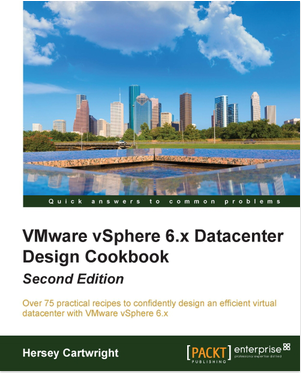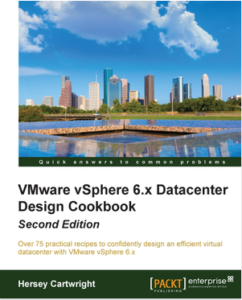
Whether you are a seasoned architect who still is getting familiar with vSphere 6 or a hands-on engineer who likes to get a firmer grip on design and architecture using vSphere 6, Hersey’s updated datacenter cookbook just might be just the book you need.
This book graciously keeps a good balance between datacenter design principles, best practices and howto’s. In this book Hersey takes you by the hand and guides you through the steps needed to create a virtual datacenter design using vSphere 6.
Besides the necessary theoretical explanations Hersey offers his readers 75 recipes which they can use to help with the creation or optimization of a virtual datacenter design: What are the prerequisites you need for a design? Who do you have to talk to? What are goals, requirements, risks and assumptions? How do you create a conceptual, logical and physical design? How do you need to calculate how many CPU, RAM or storage you need? What are the new features in vSphere 6 which might be important to my design? What basic design documentation do you need to create and how do you create it?
Across both versions of Hersey’s book the design principles have remained the same but there is no denying that vSphere 6 has a lot of differences which set it apart from vSphere 5.x. As such Hersey’s design recipes which have been modified to reflect a vSphere 6 virtual datacenter design where needed, should be a welcome read for everyone.
The structure of the book:
This book contains one chapter more than its predecessor and caps now at 12 chapters. It goes without saying that datacenter security is becoming more and more important and as such security has been assigned its own chapter. Personally I think this is a very welcome addition.
- The Virtual Datacenter
- The Discovery Process
- The Design Factors
- vSphere Management Design
- vSphere Storage Design
- vSphere Network Design
- vSphere Compute Design
- vSphere Physical Design
- Virtual Machine Design
- vSphere Security Design
- Disaster Recovery and Business Continuity
- Design Documentation
Here are some of the highlights for me:
I really have tried to find my personal highlights in this book but the thing is, in a design all of items touched in the chapters of this book are equally important. To single out some chapters as I have done in some other reviews would not only do dishonor to this book but also to the design and architecture principles themselves.
So let me tell you why I think this book is great:
– A lot of aspiring architects have a tendency to look at architecture from a technical perspective first but a change in architecture should be driven by a business need. Hersey addresses this really well in the discovery process in chapter 2. In short: A discovery process is a mix of finding out what the business needs and discovering the design factors based on requirements, constraints, assumptions and risks.
– This book reads like someone is giving you an excellent classroom experience using only a book as a medium. Just like its predecessor, the second edition of Hersey’s book “VMware vSphere 6.x Datacenter Design Cookbook” has a very good and clear structure. Each chapter builds upon the previous chapters, and where needed examples are given.
– To me and many of my friends, acquaintances and peers who have joined me on the road to VCAP5-DCD, Hersey’s previous book was a must read while preparing for exam-day. We had a good reason to read the “VMware vSphere 5.x Datacenter Design Cookbook”: It explained in an easy to understand fashion many of the topics required to know to pass the VCAP5-DCD exam and the exercises in the book were easy to follow and understand as well. Personally I would advice anyone to add this book to the collection of books to read prior to taking the VCAP6-DCV Design exam.
Why this book stands out from the crowd:
As an instructor with the VMware IT Academy program at the Tidewater Community College Hersey Cartwright knows how important a good course structure is and how critical that structure is to make sure the message will come over loud and clear. This book is a very good example of good structure. The theory, the design principles and best practices in this book are explained in such a fashion that they are easy to follow.
If you are new to design and architecture, finding the right literature to get started might be daunting. Basic principles about good design and architecture should be easily understandable for people new to these topics. Hersey’s book is a real success in this.
Kim


Leave a Reply